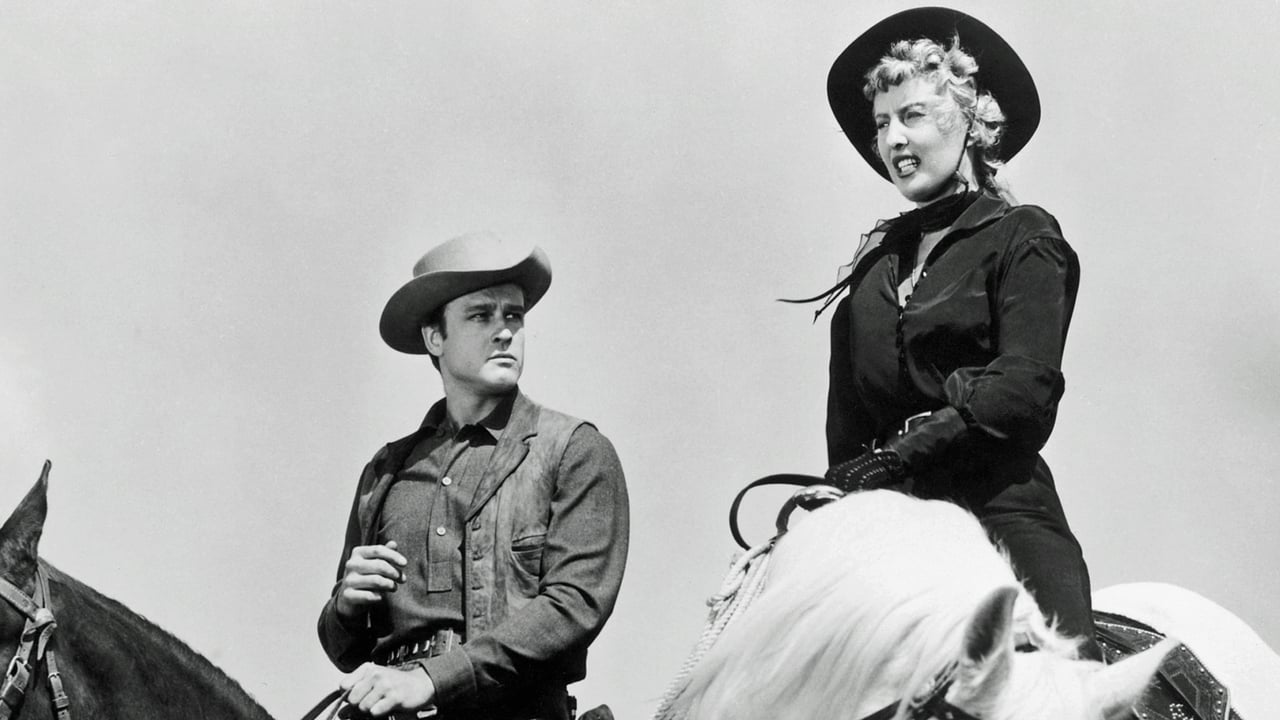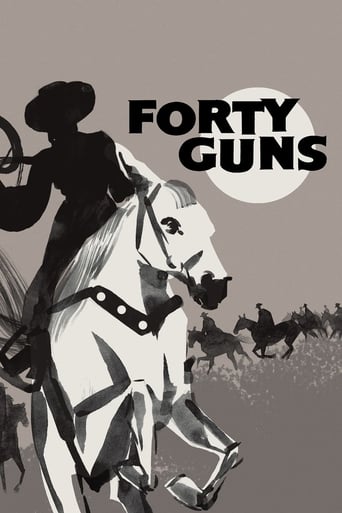



Very well executed
One of my all time favorites.
In truth, there is barely enough story here to make a film.
View MoreIt isn't all that great, actually. Really cheesy and very predicable of how certain scenes are gonna turn play out. However, I guess that's the charm of it all, because I would consider this one of my guilty pleasures.
View MoreIn 1957 western Forty Guns, Sam Fuller crams an awful lot into an 80 minute runtime; indeed a film whose runtime is double that of its titular digit and whose substance still manages to outweigh some of our more contemporary star dominated genre pictures that are twice, or even three, times as long. The film is a character piece above all else; a film depicting love coming to a zone dominated by hate, a film depicting the changing of a guard where previously a seemingly unmovable, long standing patriarchy was only ever in force and a film depicting relationships with a bit of sustenance to them where previously there were minions doing dirty work and uneasy sibling allegiances.The film will open with a sweet tracking shot, it will end with a bitter-sweet final composition as two people appear to ride off together – during the middle section, pain; affection and most things in-between bitter and sweet will play out between a handful of people in an Old West town of way-back-when. It is a charming film, a short; sharp; brisk Western made by someone between producing the likes of Pickup on South Street and The Big Red One – a film with the scope and visual flair of the latter, but with the ground out, potentially violent, B-movie feel of the former. And then there is that opening, a wondrous series of cuts and compositions depicting a number of riders hurtling towards a seemingly random horse and cart plodding along on this open, barren plain under the hot sun of the American frontier. In the wagon sit the Bonnell brothers: Wes, Chico and Griff – towards them thunder the titular forty guns, a twice-score of men whose immediate presence strikes us as potentially dangerous but whose presence in the film in relation to these three men will only remain as potentially dangerous out of the actions of its leader.And then there is that leader: a woman, a female character whose presence even appears to startle the camera itself in her reveal – a mixture of surprise and allure as we focus on this distinct, black-clad figure atop a white horse dominating the scene and in charge of those, it appears, who follow her. She is Barbara Stanwyck's Jessica Drummond, a land owner but tyrant to those in the locale around her; someone who comes equipped with a hot headed brother who'll rear up later on with its own problems. If there was a protagonist, it would be amongst the three brothers and lie with that of Griff (Sullivan); a lawman whose seen things, and most likely done things, in the past of which he isn't proud although now works on the straight and narrow. He is a man here for one of Drummond's own forty guns, for they committed a felony and must now be taken away so as to be brought to justice.Things are not that easy, and Drummond gets in the way of business. The idea of being with Drummond occurs to Griff for the first time during a public bath set sequence, a scene wherein the character is spoken about as being this indomitable, untameable person – the character even lending time to forge a meek song in her honour. It is later God himself who has to interject in order to force some sort of a tryst between the two, when Drummond finds herself caught in a natural disaster and Griff is there to remedy the situation. Away from the central tract lies the tale of Drummond's aforementioned brother Brockie (Ericson); a man with a violent streak who upsets the elements and causes havoc in the nearby town when the chief law enforcer is killed. Meanwhile, the second of those three Bonnell brothers, in Wes (Barry), strikes up their own relationship with local girl Louvenie – this is before later coming to undertake the role of this now vacant position as a law enforcer.Ultimately, the film's more interesting strand involves its trump card Drummond and its brooding lead Griff, whose nature and set of characteristics, as we witness him essentially 'go up against' Drummond, has us think that if anyone was ever change Drummond, it may very well be him. Where these two sets of factions meet in the opening scene, as if coming face to face with one another in a 'head on' fashion, Fuller's film is effectively a depiction of each group of persons respective disintegration: Griff and his brothers as these people who arrive in the land looking for someone but end up finding something else and 'The Guns' as a group of people enjoying their power and accepting it at the bereft of a female leader who take against her beginning to put other men before them. We enjoy our time with these people and we enjoy Fuller's direction, particularly how he manages to shift from this potentially aggressive relationship between Bonnell and Drummond and back again. In fact, we come to enjoy most of what's in Forty Guns.
View More"Forty Guns" effectively recycles what, even in 1957, was already a well-worn Western plot, the one about the tough but honest lawman who arrives in a small western town dominated by a powerful landowner and succeeds in restoring law and order to the community. Many such films were either straightforward retellings of the story of Wyatt Earp or fictionalised versions of the Earp legend ("Dodge City"), and this film falls into the latter category. The central character, Griff Bonnell, is clearly based on Wyatt Earp, and travels everywhere with his two brothers Wes and Chico, just as Earp was assisted by his brothers Morgan and Virgil. The one thing that sets this film apart from many treatments of a similar theme is the sex of the powerful rancher. In this film she is a woman, Jessica Drummond, and it is perhaps inevitable that she and Griff will end up by falling in love. At first, however, Jessica does not seem like a typical romantic heroine. She is a tough, ruthless lady who dominates the town and the surrounding area, ruling her territory with an iron fist and with the help of a gang of hired gunmen, the "forty guns" of the title. Griff originally arrives in the area, in fact, on a mission to arrest one of her men for mail robbery, and he soon clashes not only with Jessica but also with her spoilt, arrogant and sadistic brother Brockie. (The characterisation of Brockie Drummond is similar to that of Dave Waggoman in "The Man from Laramie", another Western of this period). The film was written and directed by Samuel Fuller. He was a director who worked in a number of genres, but I know him best for that excellent film noir, "Pickup on South Street". In some ways the plot of "Forty Guns", if updated to an American city in the mid twentieth century, with Griff as the tough-but-decent cop played by Glenn Ford, and Jessica as the glamorous but shady businesswoman played by someone like Gloria Grahame or Lizabeth Scott, could easily be that of a noir itself. The film has a complex noir-style plot and was shot in an expressionist black-and-white, even though it was made at a time when colour was increasingly becoming the norm for Westerns. (It was, however, far from being the only black-and-white Western from the late fifties; Arthur Penn's "Left Handed Gun" from the following year is another example). It also Barry Sullivan as Griff makes a rather stolid hero, but there is a good performance from Barbara Stanwyck, still strikingly glamorous and seductive in her late forties, as Jessica. (Stanwyck was five years older than Sullivan, but looks considerably younger). There is one striking scene where Jessica is dragged along the ground by a horse. I wondered how this was filmed as it seemed too dangerous for any stuntwoman to have performed, and thought that Fuller had perhaps used a dummy. The answer, in fact, is that Stanwyck performed the scene herself after her stunt double chickened out!The film was shot in CinemaScope, and Fuller uses the widescreen format to great effect. As John Ford has done earlier in films like "Rio Grande", he uses black-and-white photography as an effective medium for showing off the beauty of the Western landscapes, and as in his other films makes extensive use of close-ups. "Forty Guns" is not one of the great Westerns in the way that "Pickup on South Street" is one of the great noirs; the plot is too over-familiar and the acting is not always of the highest calibre. It is, however, a film which still retains some points of interest even today. 6/10
View MoreI came across this gem by chance after half a lifetime of devotion to the spaghetti westerns of Leone and an unshakeable belief that Once Upon a Time in the West is the greatest Western of all. Suddenly the genre makes a lot more sense. From the fantastic opening shots as Stanwyk and her 40 thieves bear down on Sullivan and his brothers, to the numerous murderous shots which come out of nowhere, to the nihilistic pronouncements of all the major characters the overwhelming impression is that all the great modern westerns were paying homage to Forty Guns in a hefty way. Even the musical moments are strangely effective. The funeral song is a haunting hint of the musical "theme" which accompanies Claudia Cardinale's walk through the station in Once Upon a Time. Add to that the smoking sexuality of a mature Stanwyk and some of the best double entendres going and this is 76 minutes of economic, cult Western heaven. Don't miss it , Clint's tension building walks down "Main street" took their first steps here !
View MoreI couldn't help but to be disappointed with Forty Guns, which sold itself to be starring Barbara Stanwyck as the leader of a pack of forty outlaws. I expected a lot more action, especially from Stanwyck. But considering she was 50 years old when she made this, I really should have had lowered expectations. She was more of a figurehead - a don, like Marlon Brando in The Godfather. I don't think he got to shoot people either. I was also disappointed that this wasn't too feminist, considering its synopsis. Sure Stanwyck got to crack a whip and order some men around, but she also fell for some man, and got her heart broken, and still threw herself at him anyway. And I got a little lost with the plot, which involved indistinguishable brothers doing bad stuff and/or getting shot, which set up for feuds. Still, it's hard to dislike a Barbara Stanwyck movie. Even when it's bad, she still brings class to it.
View More